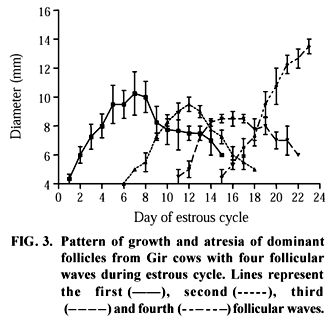📘 قراءة كتاب Exogenous control of follicular wave emergence in cattle أونلاين


Exogenous control of follicular wave emergence in cattle من كتب طب بيطرى
N
Ovarian
asynchrony
and
variability
in
response
to
treatments
remain
the
most
limiting
factors
to
the
widespread
implementation
of
advanced
reproductive
technologies
in
cattle,
despite
considerable
progress
in
recent
years
(5,7,34).
The
status
of
follicular
wave
development
is
responsible
for
a
large
portion
of
the
variability
in
ovarian
response
to
supcrstimulatory
Key
words:
bovine,
follicular
wave
emergence,
estradiol,
superovulation,
estrus
synchronization
Acknowledgments
Research
was
supported
by
the
Natural
Sciences
and
Engineering
Research
Council
of
Canada,
the
Catholic
University
of
Cordoba,
Argentina
and
the
University
of
Saskatchewan.
We
thank
Sanofi
Inc.,
Overland
Park,
KS,
USA,
for
Syncro-Mate-B;
Coopers
Agropharm
Inc.,
Ajax,
ON,
Canada
for
Estrumate;
and
Vetrepharm
Canada
Inc.,
London,
ON,
for
Folltropin-V
and
CIDR-B.
Special
thanks
to
our
colleagues
of
the
Instituto
de
Reproduction
Animal
de
Cordoba
(IRAC),
Argentina
and
the
University
of
Saskatchewan
for
technical
assistance.
Theriogenology
43:3140,
1995
0
1995
by
Elsevier
Science
Inc.
655
Avenue
of
the
Americas,
New
York,
NY
10010
0093-691W95/$11
.OO
SSDI
0093-691
X(94)0001
O-R
32
Theriogenology
treatments
and
in
the
interval
from
PGF2o
treatment
to
estrus
(26.34).
The
advent
of
real-time
ultrasonography
has
provided
a
means
to
determine
follicular
status
prior
to
gonadotropin
treatments.
However,
it
is
difficult
to
precisely
determine
the
status
of
follicular
development
on
the
basis
of
a
single
ultrasonographic
examination
and
it
is
often
not
practical
to
serially
examine
individual
animals
in
a
commercial
setting.
An
alternative
approach
is
to
control
the
development
of
a
follicular
wave
so
that
superstimulatory
treatments
may
be
initiated
at
the
most
favourable
time,
i.e.
when
the
number
of
follicles
capable
of
responding
to
exogenous
gonadotropins
is
maximal.
Similarly,
estrus
synchronization
programs
may
be
adapted
so
that
induction
of
luteolysis
is
coincident
with
the
presence
of
a
growing
dominant
follicle.
The
purpose
of
this
paper
is
to
address
theoretical
and
practical
aspects
of
bovine
follicular
development
with
respect
to
artificial
control
of
follicular
wave
emergence
and
its
application
in
superovulation
and
es&us
synchronization.
FOLLICUL
حجم الكتاب عند التحميل : 749.7 كيلوبايت .
نوع الكتاب : pdf.
عداد القراءة:
اذا اعجبك الكتاب فضلاً اضغط على أعجبني و يمكنك تحميله من هنا:

شكرًا لمساهمتكم
شكراً لمساهمتكم معنا في الإرتقاء بمستوى المكتبة ، يمكنكم االتبليغ عن اخطاء او سوء اختيار للكتب وتصنيفها ومحتواها ، أو كتاب يُمنع نشره ، او محمي بحقوق طبع ونشر ، فضلاً قم بالتبليغ عن الكتاب المُخالف:
 قبل تحميل الكتاب ..
قبل تحميل الكتاب ..
يجب ان يتوفر لديكم برنامج تشغيل وقراءة ملفات pdf
يمكن تحميلة من هنا 'http://get.adobe.com/reader/'


 منصّة المكتبة
منصّة المكتبة